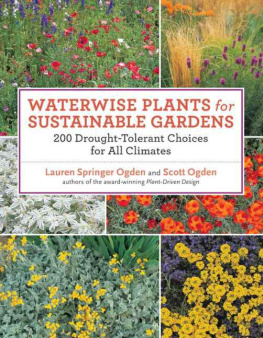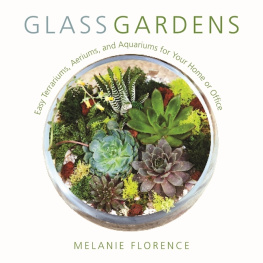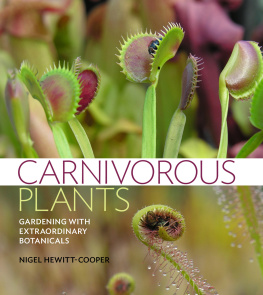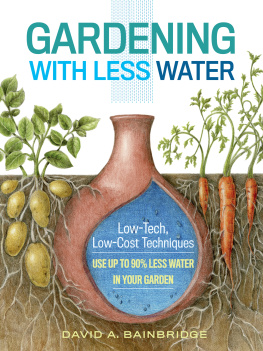Easy-Care Water Garden Plants
Charles W. G. Smith
Introduction
Water gardens are often the most beautiful gardens around any home. The blending of water and earth, garden plants with water plants, creates a harmonious balance. The sound of moving water relaxes the body and mind as it inspires the soul. Yet water gardens can be intimidating, too. At first glance they can seem to be complicated places filled with unfamiliar plants with unusual needs. But like just about everything else growing, water garden plants are simpler to care for than they first appear. The beautiful but undemanding water garden plants in this bulletin are sure to brighten your spirits as well as your garden and give you pleasure for years to come.
The water lily is the quintessential aquatic plant you may equate water garden with the sight of those scalloped green pads floating on the water. But the lily is only one of many types of plants that can grace your pond or container garden. Some plants, called submerged plants, never poke their heads above the waters surface, but they perform duties that keep your waters ecology in balance. Other plants float this way and that on the water, their roots freely dangling below. And some plants, called marginals, thrive at the waters edge and help to soften the waterline and rock border.
This bulletin tells you everything you need to know to select water plants that give you the look you want with a minimum of fuss and maintenance. Youll find vivid descriptions of each of the different types of easy-care water plants and their different varieties, zone recommendations, planting instructions, and more. Whether you want delicate floating flowers or carnivorous bog dwellers, youre sure to find suitable choices for your taste and area.

A water garden should have a balance of aquatic plants, including those that root in the pond bottom and spread up to the waters surface, such as lilies; submerged plants, which never rise to above the waters surface; and floating plants, whose roots never reach the ponds bottom.
Again, water plantsneeds are unique, but they are not intimidating. Read on to find the simple answers to these and other questions:
 How do I grow water plants?
How do I grow water plants?
 How do I keep aquatic potting soil from floating away and staining the water in my pond?
How do I keep aquatic potting soil from floating away and staining the water in my pond?
 Do water plants need fertilizer?
Do water plants need fertilizer?
 Can I overwinter aquatic plants?
Can I overwinter aquatic plants?
 Which water plants are hardy in my climate?
Which water plants are hardy in my climate?
 Are there water plants that will thrive in my container water garden?
Are there water plants that will thrive in my container water garden?
 What kinds of wildlife do water plants attract?
What kinds of wildlife do water plants attract?
Submerged Plants
In nature, the water of ponds is purified in part by plants that grow entirely underwater. These plants are usually rooted in the sediment of the pond bottom and grow up through the water toward the surface many feet above. Seen from the surface, the long and slender stems seem like graceful green strands suspended in the water.
Submerged plants, like all green plants, produce food through photosynthesis and release oxygen in the process. The oxygen produced during photosynthesis is released directly into the water and acts as a purifier. Some plants, such as anacharis (Egeria densa), produce so much oxygen that a stream of tiny bubbles often can be seen rising from the plants. For this reason submerged plants are frequently called oxygenating plants in catalogs and garden centers.
Growing Submerged Plants
Submerged plants are among the easiest of aquatic plants to grow. They do best in water 2 to 3 feet deep but will grow well in as little as 1 foot of water. In cold climates, the plants should be overwintered in areas of the pool that are at least 2 feet deep. For proper oxygenation, youll need one container of submerged plants for every 2 square feet of pond surface area. The plants are usually sold in bunches of a half dozen long, leafy stems, often without roots and held together with an elastic band or twist tie. Follow these steps for planting your new water-garden residents.
1. While you prepare their new pots, youll want to keep the submerged plants in water. Place them in a container with enough water to completely cover them and set the container in a cool, shady place.
2. For a bunch of a half dozen plants, select an 8-inch-wide plastic pot and fill it to about 2 inches from the lip with clean, moist sand. Shallow growing containers, called pans, work better than standard-shaped pots for submerged plants.
3. Make a hole in the center of the sand that is twice the diameter of the bunch of plants and about 2 inches deep. Place the plants into the planting hole and gently firm sand around the plants. Be sure that you place the cut ends, not the growing ends, of the plants into the sand. Completely cover the sand with a layer of washed pea stone or coarse gravel.
4. Remove the elastic band or twist tie from the plants, and water the container with pond water until the sand is saturated.
5. Carefully place the container in the pond. Space the plants evenly around the deep areas of the pond. The plants take root very quickly and will begin to grow even before the roots have become established.
Protect New Plants from Fish
For many water garden fish, such as koi and goldfish, submerged plants are an all-you-can-eat salad bar. If there are fish in your water garden, you can protect new plants from them with a mesh barrier. Make a dome with 1-inch metal screening or a net of bird netting and place it over the plants. Secure the barrier to the gravel; I like to bend a very large paper clip into a long, U-shaped pin to hold the screen to the bottom of the container.
Propagating Submerged Plants
Submerged plants are as easy to propagate as they are to grow. Once the plants have doubled in size, they are large enough to propagate. Simply take cuttings at least 6 inches long from the tops of the plants and plant as directed above.
Easy-Care Submerged Plants
Most submerged plants fall in the category of easy care. Once you have the plants in the water, they dont require much in the way of maintenance.
Anacharis(Egeria densa)
Zones 711
Anacharis, also called Brazilian waterweed, has very slender, long stems covered with whorls of pale green to nearly translucent evergreen leaves. Anacharis prefers full sun and still or slow-moving water 1 to 3 feet deep, but it will grow well to depths of about 10 feet. It can grow so prolifically that upper portions float on the water surface. In summer anacharis may send up small, attractive white flowers to the pond surface.
Dwarf Sagittaria(Sagittaria subulata)
Zones 511
A close relative of arrowhead, this submerged perennial produces long, straplike green leaves that grow to within 6 to 12 inches of the water surface. In shallow water the leaves often float on the surface. Dwarf sagittaria prefer still or slowly moving water from 1 foot to over 10 feet in depth in full sun to partial shade. In summer the plants bear white, three-petaled flowers in loose whorls on stems that hold the blossoms above the water.















 How do I grow water plants?
How do I grow water plants?